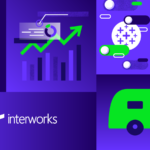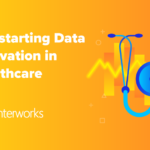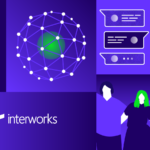Two weeks ago, my fellow content connoisseur Andrea Avey sat down with InterWorks IT gurus Scott Matlock and Tim Rhymer to talk about the impact of the cloud on IT over the past ten years. That’s some serious ground to cover, and they did a wonderful job of illuminating how the cloud has improved accessibility, performance and efficiency on several fronts. You can read that post here.
Though the worlds of IT and business intelligence are inextricably linked, I thought it might be cool to consider how the cloud has impacted to the world of BI specifically. Similarly, I also wanted to do a little future casting along the way. To aid me in this quest, I enlisted the help of InterWorks Analytics Practice Manager, Ben Bausili.
How the Cloud has Changed BI
How has the cloud changed the landscape of tech?
I think one of the best ways to conceptualize how things have changed is viewing cloud technology like a utility you can now turn on and off. That completely changes how you can approach problems. When the cloud first came out, people thought of it as simply renting out servers from another company like Amazon. In the past few years, this has grown to include not only storage but also compute and databases, covering even more of what clients care about. It makes everything easier.
What are some of the biggest benefits/advantages of harnessing the power of the cloud in BI?
A big transformation the cloud brings to businesses of all sizes is less overhead—both in terms of cost and management. Agility and scalability are two more advantages. The risk of trying new things is lessened, and the speed at which businesses can change is greatly increased. Previously, if you wanted to grow your footprint, you’d have to spend months in procurement, spend a ton of money on physical hardware, implement that with no small interruption to operations and manage all of that hardware yourself. If your business contracts, and you didn’t end up needing all those extra resources, you’re still stuck with that costly hardware.
With cloud technologies, if you need to scale up, all you have to do is purchase is more resources from Amazon, Microsoft, Google or whomever, and you have everything you need in a few clicks. If that expansion doesn’t work out, and you don’t end up needing all those extra resources, you can easily scale back down without it being a costly mistake. You only pay for what you use. That kind of flexibility allows some more freedom when growing or trying something new.
This scalability, cost savings and efficiency equate to what I think is the biggest benefit of all: businesses being able to focus more on things that provide value to their clients. The academic Simon Wardly talks about this kind of business strategy using the example of tea shops. You could spend effort building a custom tea kettle, but is that where real value goes for your clients? They could just as easily buy a stainless-steel teapot from China. Instead, a better move for a tea shop might be to focus less on manufacturing and more on improving client experience.
The same thing applies to the cloud. I no longer need to custom-build a server, backend and all that when I can buy it off the shelf ready to go instead. This isn’t just for storage and compute either. Amazon, Microsoft and Google have everything from data science models and security app frameworks available in the cloud. I don’t have to use my resources to build something new or go through a local vendor to get something delivered. It also changes how individual departments within organizations can go about getting more resources. Instead of going through the red tape of IT approval for the entire business, I can spin up a department database. Of course, it’s still best to follow IT guidelines to make sure someone isn’t running this off their laptop, but it results in less work for IT and less hassle for groups that need something more.
This scalability, cost savings and efficiency equate to what I think is the biggest benefit of all: businesses being able to focus more on things that provide value to their clients.
What are some historic concerns with the cloud? Have these concerns been resolved?
Security has always been the big one. We’ve all had our data leak at this point. Attacks are automated. It doesn’t matter if you’re a small- or medium-sized business; they’re searching for holes or easy targets. This idea that my data is out there and not in my house to control makes people nervous, but let’s go back to the advantages of scale. Who do you trust more to deal with serious attacks? A few internal IT people or experienced cloud providers with teams dedicated to testing for and solving these issues? Security will always be a problem with technology, but I trust putting my stuff under the care of experts more.
Sometimes, cost can be a consideration if someone is heavily invested in doing things on their own and wants to try and do them cheaper, but that’s rarely the case. Speaking in the context of the past decade, the early system of simply renting a server might have been cheaper depending on use case, but now the scale and adoption prices have come down. New technology has enabled new things.
The Power of Cloud-Based Solutions
When did cloud-based solutions become prominent in InterWorks offerings? Was there an “aha!” moment or has it been gradual?
I think it’s happened in different moments for different offerings. The most dramatic moment has been Snowflake. We were all familiar with Redshift, BigQuery and other tools out there doing the online database thing, but Snowflake is the first tool that was developed with the cloud in mind. They said, “How can we architect this from the ground up to do something different?” It’s mind-blowing what it can do. It’s so easy to use and much more cost-effective than traditional solutions, which is the reason we went all in with that partnership. That has made me rethink so many other tools as I look to the horizon of what’s useful for a modern analytics environment. Part of it is that new tools need to be architected like Snowflake is; otherwise, it will have trouble competing from a cost perspective.
What are some interesting cloud-based solutions currently offered by InterWorks?
Again, Snowflake is the first solution that comes to mind. I’ve heard them say that speed is free because you’re charging by compute. It doesn’t matter if you’re using it for five hours or five minutes—it’s all the same thing. You can say, “I want this ETL faster” and simply get a bigger machine for that moment, get it out when it’s done, and it won’t cost anything. That’s unfathomable in real-world scenarios. Prior to this, you’d have to spend a lot more time making code more efficient because you can’t afford a new server. With Snowflake, it’s like a water tap: you turn it on or turn it off. It doesn’t matter how fast it flows because it’s utility that you’re paying for and that’s it. It doesn’t matter how much storage or compute you have because you can scale up or down as much as you need.
How have cloud-based solutions changed the work we do and how we do it?
On a personal level, it’s just made life a lot nicer as an employee who travels. It used to be that you couldn’t access things from a phone; you had to go through a VPN and then, on top of that, had limited access to reliable WiFi. Now, we have things like Box that I can access almost anywhere, drop something in there easily and get my work done. There are a lot of little quality-of-life improvements the cloud has brought, but it’s also changed things on a greater scale of how we architect things.
Portals for Tableau is a good example of something that benefits from this new way of doing things. With Portals, we can spin stuff up in the cloud, making it faster to deploy, easier to support and ultimately cheaper for clients. With red tape removed, we can move a lot faster and repeat these results elsewhere. That lets us focus more on improving things like user experience and design.
Whether it’s Portals or Snowflake, a real benefit for consultants and clients alike is more predictability in results. We no longer have to find out who’s in charge of SAML, hardware and user access. Instead, we can spec the exact server we need, install the exact requirements and immediately access it because it’s not behind a firewall. It’s more turnkey, and ongoing support becomes faster because we have things defined from the start. Another great benefit about everything being in the cloud is that we can write one script and simultaneously update hundreds of servers in one pass.
The Limitless Future of the Cloud
How do you see cloud-based solutions growing and evolving in the future?
It goes back to what I was saying about evolving from renting servers to being able to spin up/down servers at will. Compute, functions and storage are all now separate, and I think that evolution is only going to continue. Amazon, Microsoft and Google are already focusing on how to do one thing well. Everything is getting decoupled. You don’t have to have the whole thing in the cloud either. You can select security, storage or whatever fits your strategy. That seems to be the future. Again, more things are going to be built like Snowflake because of cost, performance and flexibility. That’s what I look at when evaluating new ETL and analytics tools.
Another thought is that with the increase of subscription models, people are looking to optimize what they have, so they’re not paying too much for a service. Subscription fatigue is a thing. Done right, though, value will be more tied to what you actually use. This will, no doubt, cause some business model changes. I don’t think the next gen will have any thoughts that there’s a different way.
Why does the cloud matter? Where would we be without it?
It’s changed everything, even in ways we don’t readily think about anymore because we take for granted how integrated it’s become in our day-to-day. We’ve said it a lot already, but without the cloud, we wouldn’t have near the speed, flexibility and ease of access we have today.
Ten More Years of Progress and Possibility
It’s pretty clear that the cloud has transformed the way businesses and consumers alike interact with tech. With the pace of technological change ever increasing, it will be fascinating to see how the cloud evolves in the coming year and the coming decade. Some paths we can see, but there will doubtless be new ways of operating that we can’t even begin to imagine.
Are you interested in learning more about the cloud? Maybe you need support navigating some of your current cloud-based solutions or you’re looking to migrate. InterWorks can help! Reach out today, and let’s talk about how we can help you step into the future you want.






